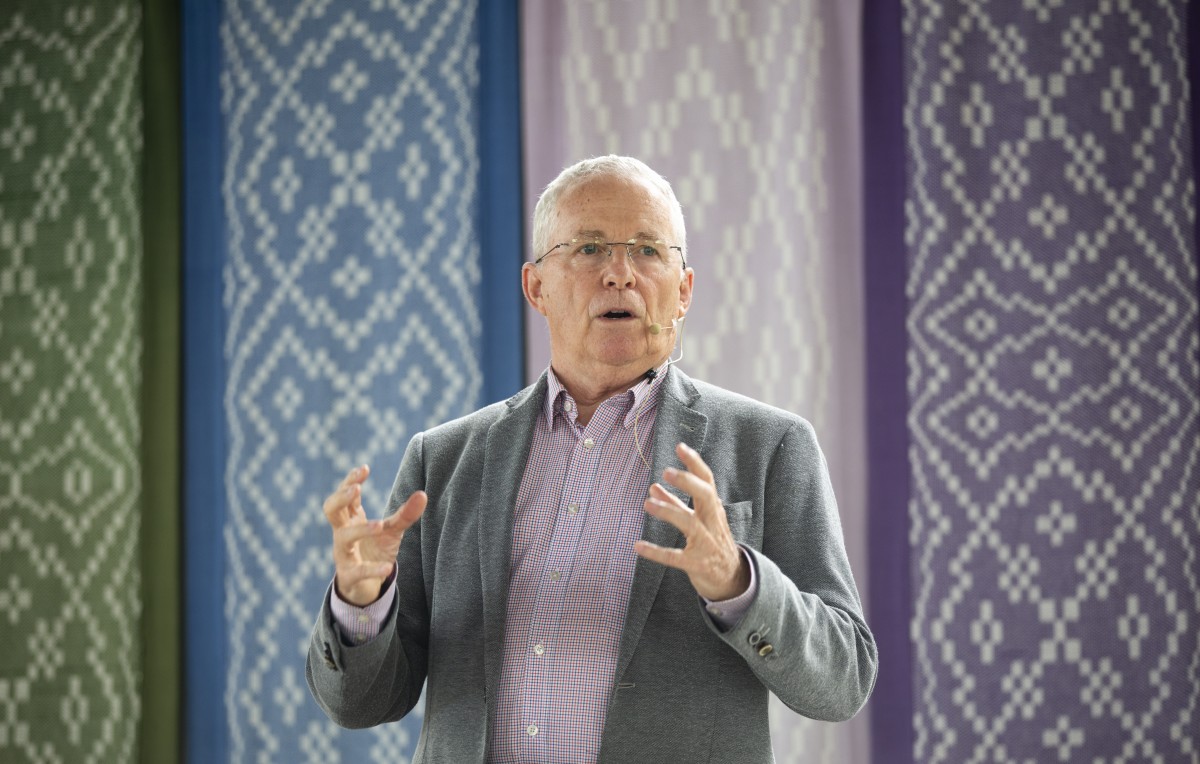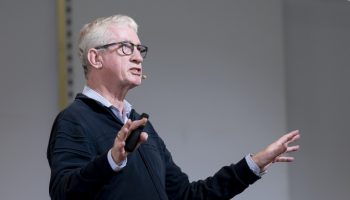As a former combat officer on a U.S. Navy destroyer, Lutheran chaplain at Cornell University, co-creator of the Leadership Institute of Seattle Graduate Program, therapist, author and magician, the Rev. John Scherer has mastered the art of doing it all. Now, he works to help others do the same.
At 2 p.m. Wednesday, Aug. 1, in the Hall of Philosophy, Scherer, founder and president of Scherer Leadership Center, gave his lecture, “Seva as Sadhana: Workplace as Spiritual Development Dojo,” as part of Week Six’s interfaith theme, “The Spirituality of Work.”
Acknowledging that every audience member is a “work in progress,” Scherer began by posing a question:
“What if you could see that every day you are going into work, you are going into a classroom, or a dojo, where you get to practice and develop yourself?” he said.
Scherer’s answer to that question is derived from his latest book, Five Questions that Change Everything: Life Lessons at Work. According to Scherer, the five questions he compiled will “change everything.” Everything except for one’s self, the “one thing that never needs to change.”
“You do not need to change yourself. You need to come home to yourself,” he said. “That changes everything.”
Scherer said steering people away from the mindset of being “more (of) this, less (of) that” was the founding principle of his leadership program in the 1980s.
“(It’s) not about trying to be somebody else, but discovering more fully and deeply who is alive in there and bring that to the world,” Scherer said.
The first of the five questions is: What confronts you? To give more depth to this question, Scherer used a metaphor of a tiger.
“If you were in a jungle in India and a tiger came up on you suddenly, what would the human instinct be to do?” he said. “Run.”
Scherer said if one runs, instinct also kicks in inside the tiger’s brain.
“It sees that small, slow figure trying to run away, the yummy one with the crunchy center, and the tiger sees lunch,” Scherer said. “The cat is hard-wired to chase something trying to run away, so if you run away, your chances of survival are zero.”
However, if one turns and faces the tiger, the tiger will process that reaction and think about it, Scherer said.
“If you think about it for a second, that is fairly significant,” he said.
Scherer said if one’s chances of survival by running is zero, and the chances of survival in facing the tiger are “something greater than zero, it is probably a chance worth taking.”
Scherer then asked the audience what the tiger represents in their own lives.
“Who is a difficult person in your life right now, a difficult relationship?” Scherer said. “What is a decision you are having trouble making? What is something going on in your circle of in uence that doesn’t feel right, that you are hesitating to confront?”
Scherer said something that has assisted him in confrontation is practicing aikido, a traditional Japanese martial art.
“Aikido has been very important to me in reframing something,” he said. “When something is coming at me, I am trying to figure out how can I get off the line of attack and figure out what the lesson is.”
The second question is: What am I bringing to this encounter?
“If I were to face the tiger, what am I bringing?” he said. “My hopes? My fears? My intentions?”
The third question is: What has been running me? For this question, Scherer used a metaphor of a hamster running in a wheel.
“How is my life like the hamster in the wheel?” Scherer said. “It might be a lovely, lovely life, but how is it lovely in the wheel? It might only be lovely in the current wheel, and that is better than having a life in a wheel that’s not very lovely, but it is still a life inside of a wheel.”
A life inside the wheel means “every day is the same, only a little different,” Scherer said.
“What you hope for is incremental change,” he said. “Maybe I can make this a little better, maybe I can make my relationship with my partner a little better, my kids, my neighbor, whoever.”
Scherer said what runs people is “default.”
When working with executives and senior-level management in his leadership program, Scherer often sees that people are trying to be a persona, rather than a person.
“We wake up in the morning, and we pump up that persona,” he said. “Whether it’s a mom or a dad or whatever your roles are, you put on the role, and meanwhile, behind that pump-up doll is a real person. That is the position.”
Scherer believes alternating between position and person causes an internal disconnect.
“That’s why you feel like something isn’t working,” he said. “You are not here to be the position, you were created to be the person that is inside of the position.”
The fourth question is: What calls me?
“What calls out from inside you?” Scherer said. “What are your charisms? What are your gifts?”
Scherer said charisms are what one is good at, but has never been taught.
In addition, Scherer asked, “What calls from outside one’s self?”
As an example, he told a story of his son Asa. One day when Scherer was coming home, he heard Asa playing the grand piano in their living room. Scherer said he could feel the entire house shaking, and that is when he had a realization. The realization was that it was not the piano or the music that was shaking the house — it was Asa.
“Nothing happens until he places his hands on that keyboard,” Scherer said. “Your job, your work is just your piano. Nothing happens until you take your uniqueness, your God-given charism, and you put your hands on that keyboard.”
The fifth questions is: What will unleash me?
Scherer said this question is derived from the basis of the Aramaic name for salvation, which is to be “delivered, released or set free.”
“It is the word Jesus would have used if he talked about salvation,” he said. “(Jesus) never asked people, ‘Do you believe this, this and this?’ ” he said. “ ‘You are seeing something, you are coming here to me, and that has already set you free.’ ”
Ultimately, Scherer said he believes everyone was put on earth with an assignment.
“A great theologian said, ‘We show up here with sealed borders,’ ” he said. “How do you discover what your sealed borders are? That is what life is about: discovering why we are here.”
To figure out one’s purpose, Scherer suggested three things:
“First, why we are here? (For) continuous development, continuous discovery of the soul and the essence of who we are,” he said. “Second, expressing whoever that is out into the world as fully and free without abandonment. And the third thing is (to live) in such a way that that contributes to the creation of life in the way it could be. I guarantee one of those questions will be a key that can unlock the door to your greatest life.”








